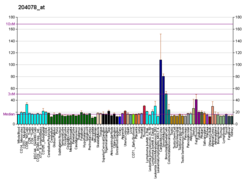Protein-coding gene in the species Homo sapiens
| P3H4 |
|---|
|
| Identifiers |
|---|
| Aliases | P3H4, NO55, NOL55, SC65, LEPREL4, prolyl 3-hydroxylase family member 4 (non-enzymatic), prolyl 3-hydroxylase family member 4 (inactive) |
|---|
| External IDs | OMIM: 617419; MGI: 1913430; HomoloGene: 4713; GeneCards: P3H4; OMA:P3H4 - orthologs |
|---|
| Gene location (Human) |
|---|
 | | Chr. | Chromosome 17 (human)[1] |
|---|
| | Band | 17q21.2 | Start | 41,801,947 bp[1] |
|---|
| End | 41,812,604 bp[1] |
|---|
|
| Gene location (Mouse) |
|---|
 | | Chr. | Chromosome 11 (mouse)[2] |
|---|
| | Band | 11|11 D | Start | 100,299,282 bp[2] |
|---|
| End | 100,305,662 bp[2] |
|---|
|
| RNA expression pattern |
|---|
| Bgee | | Human | Mouse (ortholog) |
|---|
| Top expressed in | - stromal cell of endometrium
- periodontal fiber
- tibia
- ventricular zone
- anterior pituitary
- right lobe of thyroid gland
- left adrenal cortex
- tendon of biceps brachii
- right adrenal gland
- body of pancreas
|
| | Top expressed in | - calvaria
- molar
- epithelium of lens
- belly cord
- upper jaw
- body of femur
- supraoptic nucleus
- vestibular membrane of cochlear duct
- ascending aorta
- right ventricle
|
| | More reference expression data |
|
|---|
| BioGPS |  | | More reference expression data |
|
|---|
|
| Orthologs |
|---|
| Species | Human | Mouse |
|---|
| Entrez | | |
|---|
| Ensembl | | |
|---|
| UniProt | | |
|---|
| RefSeq (mRNA) | | |
|---|
| RefSeq (protein) | | |
|---|
| Location (UCSC) | Chr 17: 41.8 – 41.81 Mb | Chr 11: 100.3 – 100.31 Mb |
|---|
| PubMed search | [3] | [4] |
|---|
|
| Wikidata |
| View/Edit Human | View/Edit Mouse |
|
Synaptonemal complex protein SC65, also known as Leprecan-like protein 4 (LEPREL4) or nucleolar autoantigen No55, is a protein that in humans is encoded by the LEPREL4 gene.[5]
Function
This nucleolar protein was first characterized because it was an autoantigen in cases on interstitial cystitis. The protein, with a predicted molecular weight of 50 kDa, appears to be localized in the particulate compartment of the interphase nucleolus, with a distribution distinct from that of nucleolar protein B23. During mitosis it is associated with chromosomes.[5]
References
- ^ a b c GRCh38: Ensembl release 89: ENSG00000141696 – Ensembl, May 2017
- ^ a b c GRCm38: Ensembl release 89: ENSMUSG00000006931 – Ensembl, May 2017
- ^ "Human PubMed Reference:". National Center for Biotechnology Information, U.S. National Library of Medicine.
- ^ "Mouse PubMed Reference:". National Center for Biotechnology Information, U.S. National Library of Medicine.
- ^ a b "Entrez Gene: SC65 synaptonemal complex protein SC65".
Further reading
- Foster LJ, Rudich A, Talior I, et al. (2006). "Insulin-dependent interactions of proteins with GLUT4 revealed through stable isotope labeling by amino acids in cell culture (SILAC)". J. Proteome Res. 5 (1): 64–75. doi:10.1021/pr0502626. PMID 16396496.
- Gerhard DS, Wagner L, Feingold EA, et al. (2004). "The status, quality, and expansion of the NIH full-length cDNA project: the Mammalian Gene Collection (MGC)". Genome Res. 14 (10B): 2121–7. doi:10.1101/gr.2596504. PMC 528928. PMID 15489334.
- Ota T, Suzuki Y, Nishikawa T, et al. (2004). "Complete sequencing and characterization of 21,243 full-length human cDNAs". Nat. Genet. 36 (1): 40–5. doi:10.1038/ng1285. PMID 14702039.
- Strausberg RL, Feingold EA, Grouse LH, et al. (2003). "Generation and initial analysis of more than 15,000 full-length human and mouse cDNA sequences". Proc. Natl. Acad. Sci. U.S.A. 99 (26): 16899–903. Bibcode:2002PNAS...9916899M. doi:10.1073/pnas.242603899. PMC 139241. PMID 12477932.
- Fosså A, Siebert R, Aasheim HC, et al. (2000). "Identification of nucleolar protein No55 as a tumour-associated autoantigen in patients with prostate cancer". Br. J. Cancer. 83 (6): 743–9. doi:10.1054/bjoc.2000.1365. PMC 2363543. PMID 10952778.
- Suzuki Y, Yoshitomo-Nakagawa K, Maruyama K, et al. (1997). "Construction and characterization of a full length-enriched and a 5'-end-enriched cDNA library". Gene. 200 (1–2): 149–56. doi:10.1016/S0378-1119(97)00411-3. PMID 9373149.
- Ochs RL, Stein TW, Chan EK, et al. (1996). "cDNA cloning and characterization of a novel nucleolar protein". Mol. Biol. Cell. 7 (7): 1015–24. doi:10.1091/mbc.7.7.1015. PMC 275955. PMID 8862517.
- Maruyama K, Sugano S (1994). "Oligo-capping: a simple method to replace the cap structure of eukaryotic mRNAs with oligoribonucleotides". Gene. 138 (1–2): 171–4. doi:10.1016/0378-1119(94)90802-8. PMID 8125298.


















